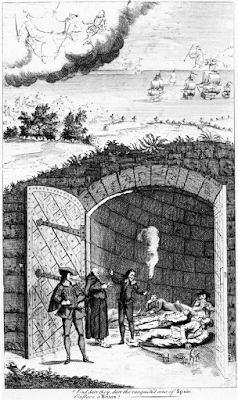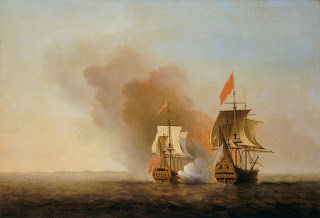---oOo---
6 June 1762, circumnavigator, naval hero and reformer of naval affairs George Anson, 1st Baron Anson, died aged 65 at Moor Park in Hertfordshire
“Thus was this expedition finished, when it had lasted three years and nine months, after having, by its event, strongly evinced this important truth: That though prudence, intrepidity, and perseverance united are not exempted from the blows of adverse fortune, yet in a long series of transactions they usually rise superior to its power, and in the end rarely fail of proving successful.“ (Anson's Voyage Round the World by Richard Walter)
 |
| A caricature of 1738 showing British tars in a Spanish jail in the West Indies, praying for rescue by the navy and conjuring the spirits of Cavendish, Raleigh and Drake |
The “War of Jenkins’ Ear” was certainly one of the most peculiarly named conflicts in history. Actually, Thomas Carlyle came up with the odd denomination a hundred years after the war had finally ended in 1748, based on the incident that became the alleged casus belli. Back in 1731, the commander of a Spanish patrol boat had boarded the English merchantman “Rebecca” to search her for contraband violating the conditions of the Asiento, the monopoly of selling slaves to Spanish America, granted to Britain after the Peace of Utrecht in 1713 and passed on to the South Sea Company. British merchants, especially those in the West Indies, applied an excessively wide interpretation of the treaty and shipped trade goods of all kinds to the Main. With the firm Spanish trade rules still in place, the colonial masters of the New World viewed this flow of goods as smuggling like they did back in Drake’s day and were, according to contemporary international law, in the right. Robert Jenkins, the master of the “Rebecca”, protested and tried to stop the guarda costa of Spanish Florida from searching his ship. The Spanish commander promptly drew his sword and cut off Jenkins’ ear, after he had conveniently bound him to the mast to hold still, and uttered the famous words: "Go, and tell your King that I will do the same, if he dares to do the same." Whether “smuggling” was meant by the Spanish capitán with “the same” or “talking back to a Spanish officer” or “sailing off Florida” or all three together is lost in history along with the fact if Jenkins really was shipping contraband or not over the Spaniard’s bravado and acting like the villain from an early Hollywood pirate movie. However, Jenkins and the “Rebecca” made it back home to England along with the cut-off ear, pickled in alcohol. The corpus delicti was presented to the House of Commons and, after a bit of diplomatic and internal toing and froing, war was declared on Spain in 1739 over the insult to the honour of the nation. Political pressure of the West Indies merchants to stop the Spanish from revoking the monopoly of the Asiento and maybe even to force open the ports on the Main at gunpoint has certainly played a role in the decision.
 |
| George Anson's capture of a Manila galleon. Samuel Scott (before 1772) |
 |
| Lord Anson's victory off Cape Finisterre, 2 May 1747 |
 |
| George Anson, 1st Baron Anson. Anonymous. |
And more about Admiral Anson on:
http://en.wikipedia.org/wiki/George_Anson,_1st_Baron_Anson
and his circumnavigation on:
http://en.wikipedia.org/wiki/George_Anson%27s_voyage_around_the_world
About the Author
Blood and thunder, artsy things, curiosities and lots of ships, everything featured in my little #onthisday-series. I post a daily feature about something that happened “on this day”, weather permitting.
Usually, the posts turn on Literature with a heavy focus on the 19th and early 20th century and silver screen adaptions. The dark and macabre, vampires, ghosts and ghoulies, the plain fantastic, the Byronic tradition in Europe, dandyism as well as Thomas Mann, Dostoevsky and Nietzsche. History, often military history, from antiquity to the dawn of the 20th century and everything an armchair sailor can come up with. Fine arts with pretty much the same foci during the said period as well as Mythology.
And besides that I currently collect curiosities online, often with a touch of #steampunk and exhibit them in my virtual #wunderkammer, an online cabinet of curiosities.
http://wunderkammertales.blogspot.de
Written content of this post copyright © Dirk Puehl, 2015.
4 comments:
http://www.ebay.co.uk/itm/authentic-shipwreck-Armada-galleon-driftwood-treasure-/291576773356?hash=item43e3547aec
Are you going to treat yourself?
Please excuse my late response, dear Mme Gilflurt... I was terribly busy yesterday and... well, I am so proud, honoured, glad and what not, that it worked out - I do hope your readers like the narrative as much as I cherished writing it as a feature for your salon, my dear.
Thank you so much, sir, the honour was all mine!
Post a Comment